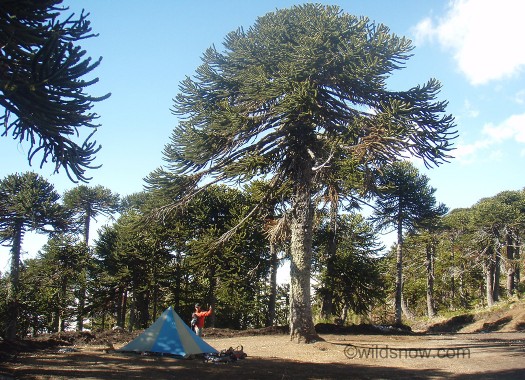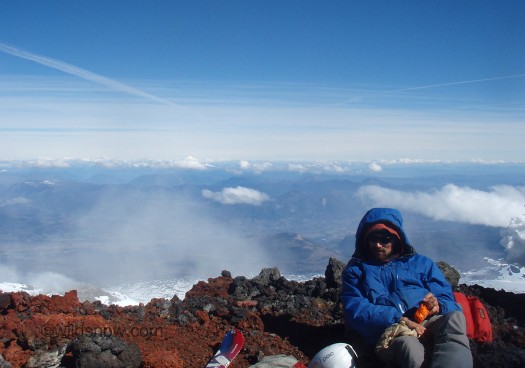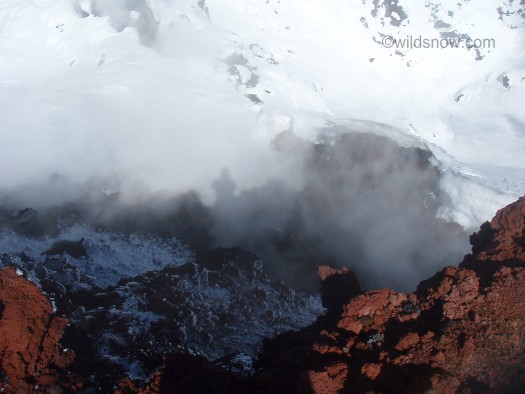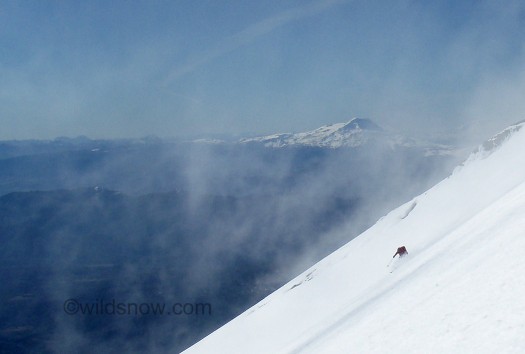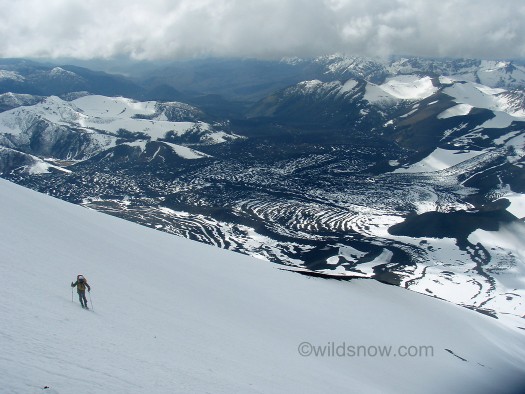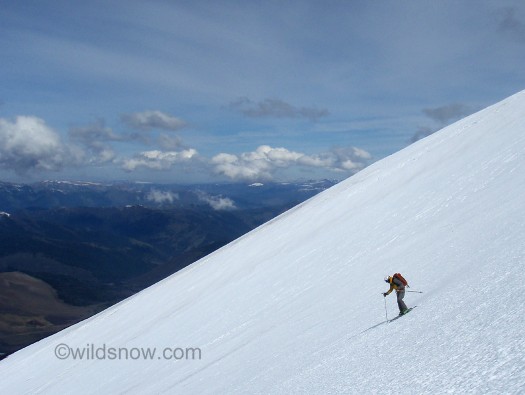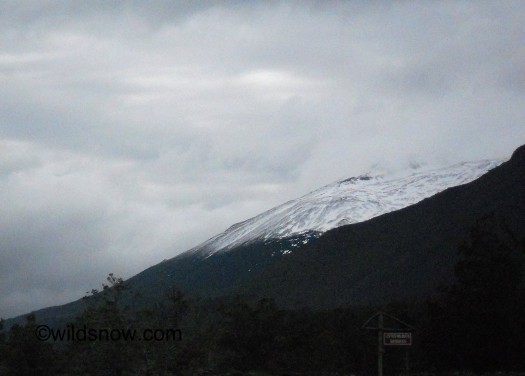Skyler Mavor
“Do you believe in god?” I´m chatting with an old man who sat down to talk as Louie and I try to hitch to Volcan Llaima. His question catches me a bit off guard, and he seems to assume that my silence means that I didn´t understand his Spanish. Changing the subject, I ask if he´s ever seen the volcano erupt, and how long ago that was. “Yes, a while ago.” He doesn´t seem to give it much thought.
A photo in a local empanada shop shows the volcano spewing lava high into the air, putting an orange glow in the evening light. The photo looks grainy and old, so I´m surprised to hear that its from 2008, and that the most recent eruption was in 2010. I’m starting to feel like this trip has become an adventure in volcanic tourism. From the lava flows and crater of Puyehue to the hot springs of Chillan, we´ve been spending a lot of time on volcanoes that can (and do) erupt suddenly and frequently. It seems that Llaima will be no exception. (A Google image search for Llaima eruption shows some amazing photos, and here’s a video, yeah, we skied that!)
We have no luck hitching to the mountain, and hire a local guy named Pablo to drive us the last few kilometers in his jeep. Our ride with him is our second trip in a sketchy vehicle that day; we got a ride to the Temuco bus station by our hostel owner that morning in a hilariously decrepit car. We strapped our ski bag on his roof with a minimal amount of webbing, stuffed our gear into the tiny backseat, and push started his jalopy until the engine reluctantly turned over. I held the passenger door closed with my arm as we woved our way through the local market to the rural bus terminal. I guess that´s how it´s done in Chile, proper style.
After stopping to add a liter of oil to the engine, Pablo´s rig got us to the ski area as the sun sets. Llaima is famous for its forest of araucaria trees that surround the mountain. They´re funky plants, they have spiky triangular leaves that cover the branches, and many of the trees form a kind of umbrella shape and lose the lower branches. They look as if you mixed a fir tree, a palm tree, and a cactus. We´ve seen these things a number of times in our travels, near Lanin and elsewhere in the area, but never in such numbers as the lower slopes of Llaima. We set up camp under a big tree and hit the sack.
We get “splitter” weather the next morning, and by midmorning we pass above the ski area. The upper volcano looks like it offers several route choices. We´re torn between gunning for the coolest looking line and chasing the best snow. Well, sometimes you can have your cake and eat it too — the best snow seems to be on the steeper face that Louie and I agree would be the choice route. It´s hard to get a sense of scale sometimes on these volcanoes, but a couple hours of skinning and cramponing gets us to the top of the face. As we approach the summit, the steam vents appear in areas of thin snow, and at the summit we find that the crater is covered in vents blowing steam almost constantly. “Did you fart or was that just the volcano?”
After a minute or two on top, we notice a trio of skiers heading up from the north side. They join us on the summit; they´re ski mountaineers from France down here for three weeks. It´s the first time on this trip that we´ve shared a summit. “Americans? That would explain the big skis!” I´m on a pair of 175cm Coombacks, tiny by my standards. I think my powder skis would blow this guy´s mind.

Hiking through steam to the top of Llaima. You have to be careful skinning up the snow, as fumaroles melted big cavities, sometimes thinly covered.
We talk about things we´ve skied, and things we hope to ski. Louie tells the Frenchmen that this is our ninth volcano summit. Ninth? I start counting through our volcano list and almost run out of fingers.
The descent is steep enough that it might get my blood flowing if the snow is like the other volcanoes. However, it´s a warm day, and we enjoy perfect spring corn down the west face back to the lifts. Just pleasant. We hitch down to the nearest town, where I track down Pablo and he kindly offers to let us camp in his driveway.
We resupply the next day in the markets of Temuco between bus rides. The markets here are amazing. You can find whatever you need: food, clothing, electronics, even live chickens and ducks. Our ski boots, big packs, and bad Spanish make us stick out. We can barely manage to squeeze our boots between some of the vendor stands. Organization of the place is comical. It seems that there are fifteen vendors that sell the same item, often immediately next to each other. After wandering for a while, I find an entire block of shoe vendors, each with a haphazard assortment of styles and sizes. We buy a kilo of amazing spiced cheese from a vendor that calls out prices like an auctioneer, and manage to find some dried figs from a vendor hidden behind barrels of dog food. Street food here is delicious, and we get some kebab-style grilled meat sticks for lunch.
We keep our northwards momentum and head to Lonquimay next. We hitch a lucky evening ride up to the ski area and spend the next night there, and score another night of free camping. “Fall into place.” Things just seem to work out on this trip. We came down here with basically zero itinerary, and the weather and logistics seem to line up of their own accord.
The next morning we hit a bump in our road. The night was windy, we sleep through our alarm and wake up to grey skies and rough gusts. We talk about not skiing, but one of the lifties tells us that tomorrow will be worse. We decide to head up, perhaps because we´d rather get shut down today than hang out at the base waiting for a weather change.
We have a cold, windy lunch of dried fruit, animal crackers and that amazing spiced cheese. We´re in a pretty solid routine now, so the switch from skins to crampons is no surprise. We seem to be on the lee side of the volcano, and we watch clouds race by as we near the top. Lonquimay has a crater similar in size to Llaima but without the steam vents (I think that the most recent activity has moved from the main massif to the Navidad crater lower on the slopes). We consider doing a short ski into the crater, but it seems a little anticlimactic after our ski into Puyehue. Can´t top that.
The next day we head farther north to Volcan Antuco. We hear a couple warnings that there´s little snow there, but rumor has it that the ski area is open, so it can´t be that bad. We catch a (terrifying) ride in a guardaparques pickup most of the way, and set up camp. The next morning is cloudy, we don´t bother to check the weather since this is the last day that we could ski before we head to Santiago to finish our trip. A momentary break in the clouds gives us a glimpse of the volcano. We can see that it is nearly devoid of snow. The ski area is definitely not open, as there is no snow at all under the lifts. We bail on our plans to ski due to the clouds and the amount of dirt walking, and do a short hike to salvage the day. We hitch back to Los Angeles with Leon, a cool Italian that works at a Chilean winery (apparently he found and enjoyed the cheese we left in his car!). He’d tried to ski Antuco that morning but was shut down by the clouds.
Now that we´re near the end of our journey, we´ve started counting things to keep track: seven weeks in South America, over 30 ski days, ten volcanoes skied, nineteen nights spent in refugios, 35 bus rides, more than 200 empanadas, zero chairlifts. Good trip!
Beyond our regular guest bloggers who have their own profiles, some of our one-timers end up being categorized under this generic profile. Once they do a few posts, we build a category. In any case, we sure appreciate ALL the WildSnow guest bloggers!


